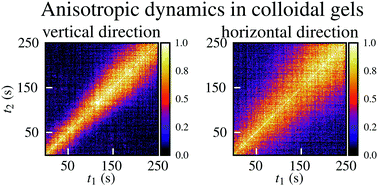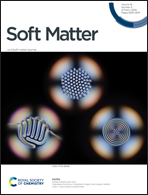Anisotropic and heterogeneous dynamics in an aging colloidal gel†
Abstract
We investigate the out-of-equilibrium dynamics of a colloidal gel obtained by quenching a suspension of soft polymer-coated gold nanoparticles close to and below its gelation point using X-ray Photon Correlation Spectroscopy (XPCS). A faster relaxation process emergent from the localized motions of the nanoparticles reveals a dynamically-arrested network at the nanoscale as a key signature of the gelation process. We find that the slower network dynamics is hyperdiffusive with a compressed exponential form, consistent with stress-driven relaxation processes. Specifically, we use direction-dependent correlation functions to characterize the anisotropy in dynamics. We show that the anisotropy is greater for the gel close to its gelation point than at lower temperatures, and the anisotropy decreases as the gel ages. We quantify the anisotropic dynamical heterogeneities emergent in such a stress-driven dynamical system using higher order intensity correlations, and demonstrate that the aging phenomenon contributes significantly to the properties evaluated by the fluctuations in the intensity correlations. Our results provide important insights into the structural origin of the emergent anisotropic and cooperative heterogeneous dynamics, and we discuss analogies with previous work on other soft disordered systems.



 Please wait while we load your content...
Please wait while we load your content...